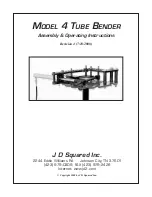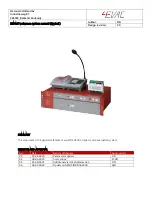
FARMI 4670
22
You can use the example for calculating the stand
stability for any tractor by measuring ”K” and ”H”
from the tractor. With these measures you can
calculate ”C”.
K = Distance between the tractors rear shaft and the
cranes pivot point
H = Tractors wheelbase
See the tractors manual for rear axle weight M3,
“n” value must be more than 1.
TESTING THE STABILITY
The formulas and examples included in these instruc-
tions are based on the SFS 4677 standard.
During the test, the vehicle is in normal working con-
dition without load, tilted 5
o
to the side. The ground
must withstand the maximum load applied by the
wheels or the other points of support.
The test is performed at the maximum reach with 10%
overload. All normal crane functions are performed,
but cautiously. The vehicle’s 5
o
inclination is achieved
by putting a suitable riser under one of the rear wheels.
Its height can be calculated as follows:
h = riser height needed
z =vehicle width from wheel center to wheel center
h = 0.087 x z
Example:
z =180 cm
h = 0.0887 x 180 cm = 16 cm
The vehicle is considered stable if no more than one
point of support rises off the ground during the test.
Increased stability when loading it from the side can
be achieved by lengthening the track and/or adding
rear axle load by using, for example, wheel weights.
DETERMINING THE STAND-STABILITY BY
CALCULATION
The crane is considered stable when the stability ratio
”n” calculated from formula below is equal or larger
than 1.
EXAMPLE 1
A1 = Normal distance from cranes turning center to
overturning edge.
B1 = Normal distance from booms end (load) to over-
turning edge.
C1 = Distance from vehicles rear axles center and
overturning edge.
E1 = Normal distance from booms point of support
to overturning edge.
G = Maximum load at distance A + B
N = Cranes weight without booms
P = Booms weight (centroid)
M2 = Rear axle weight without load
n1 = Stability factor
Formula
C =
H x A
K + H
EXAMPLE 2
A2 = Normal distance from cranes turning center to
overturning edge.
B2 = Normal distance from booms end (load) to over-
turning edge.
C2 = Distance from vehicles rear axles center and
overturning edge.
E2 = Normal distance from booms point of support
to overturning edge.
G = Maximum load at distance A + B
N = Cranes weight without booms
P = Booms weight (centroid)
M3 = Rear axle weight without load
n2 = Stability factor
All manuals and user guides at all-guides.com
















































